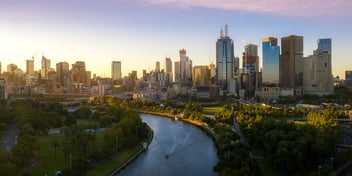Understanding our cultural heritage and waterways – technology taking us back AND into the future

I’m sure many of us have reflected on our surroundings when out walking and wondered what the area must have looked like before colonisation and development by European settlers. In the water sector, we are being challenged in the realm of integrated water management to plan development around natural ecosystems, rather than despite them. What follows here is an introduction into a remarkable blending of reflection and insight, as disrupted waterways and environments are brought to life, inspired, and developed in a digital, immersive way by Brett Leavy and his team at Bilbie Virtual Labs.
INTRODUCTION TO BRETT LEAVY
Brett Leavy descends from the Kooma people whose traditional country is bordered by St George in the east, Cunnamulla to the west, north by the town of Mitchell, and south to the QLD/NSW border, but he was born in Sydney, growing up in Blacktown before moving to live in Brisbane and the Gold Coast.
His vocational path was inspired by his mother who, being forced to leave school in grade four, had to work on a cattle property far from family. She loved to read and learn early the value of education for rising above her circumstance. She instilled strong values of education in her children and the importance of learning as much as possible. Brett channelled his determination early in life into sporting excellence. As a full-time professional athlete, he won the National Under 20’s 200m final and competed in Senior Nation 100m finals for over a decade, and as a winger for the Junior Wallabies Rugby Team defeated NZ U21 in 1986. Following this career, he started work in high schools but later changed careers, rising to the General Manager of the National Indigenous Media Association, establishing the National Indigenous Radio Service, overseeing the connection via satellite and the consolidation of over 100 community radio stations dotted across Australia.
Now, for over two decades, he devotes his awake time to the research, design, and development of a digital storytelling software development toolkit, using new immersive and interactive technologies like augmented reality and virtual reality to authentically display, showcase and represent the traditional knowledge and historical associations of First Nations people using these immersive and interactive tools.
Presently, Brett heads Australia’s leading First Nations social impact cultural and virtual design company – Bilbie Virtual Labs. Their mission – accepted by this ‘Virtual Heritage Jedi’ – is the design of Virtual Songlines, as a suite of immersive, interconnected multi-user virtual heritage simulations that showcase the history and heritage of First Nations people where our capital cities and regional towns now exist across Australia.
Brett collaborates with historians, designers, developers, and programmers to deliver these virtual heritage experiences that begin with the virtual landscape metaphor and to then embed First Nations perspectives through authentically, and comprehensively modelling in 3D these spaces. He argues that gamification showcased through PC, augmented and virtual reality (VR) technologies can become an effective tool for the immersive users with an authentically recreated heritage and cultural space where First Nations people can tell their stories of connection to country.
There are many examples of Brett’s work and where Virtual Songlines projects have been installed - Cross River Rail has an Experience Centre and they have taken up the challenge to acknowledge and honour the cultural heritage of the Turrabul and the Jagera within their project’s alignment through inner and outer Brisbane. Anyone who visits the Experience Centre are taken on a trip beyond our colonial past to wander and explore the native bushlands that covered the area that is now the Brisbane CBD.
In Brett’s own words, he describes his purpose as follows:
“Virtual Songlines seeks to really immerse people within our culture and community. We seek to gain that respect through greater understanding and to acknowledge our people and their custodianship of the land that has sustained our people since time immemorial - but particularly in our cities and regional towns where First Nations presence has been effectively eradicated. I have taken up the challenge of using these immersive and interactive technologies to allow anyone to walk in the footsteps of our ancestors and this medium is the best way to achieve that.”
VIRTUAL SONGLINES - CREATING VIRTUAL WORLDS OF OUR RICH CULTURAL AND ENVIRONMENTAL HERITAGE
Virtual Songlines offers anyone the chance to engage with our applications that virtually render the culture and heritage values of First Nations people for the purposes of presenting, preserving and promoting this knowledge. To date, the Bilbie Virtual Labs team has focused efforts on the development of a Virtual Heritage Software Development Kit (SDK), to accurately represent, through gamification, VR/AR environments, and video installations cultural heritage. Rapid advancements in digital technology such as game theory, computer processing power and development software have made the vision possible, from early beginnings where Brett and his people would pour over maps, to now telling stories about country and culture in virtual reality. Their mission is to cost-efficiently, authentically and comprehensively deliver over fifty virtual heritage landscapes related to cities and regional towns across Australia. It is no small wonder, and irony, that an ancient culture, borne over thousands of years, can be recreated and presented to us via 21st century technology in such a meaningful way.
The virtual landscapes strive to ensure that the First Nations people are respected and represented as the original inventors, knowledge keepers and innovators in sustainable land use so users can gain a greater understanding of our connection to our land and cultural heritage. This is a critical part of our journey, as we strive in turn to understand this heritage and use it as the basis for the future planning for our cities.
“Gamifying” the process draws the viewer into the landscape and cultural practice, providing a perspective that would not be possible with only written words and maps as references. Through gamification, players earn respect through proper cultural acts, caring for the country and applying traditional values. These acts are vital to the renewal of identity - but also for Australians wanting to gain an insight about our people and our diversity.
3D overlays of our built environment have been created to overlay the natural environment, powerfully conveying the fact that the true city ‘is below those bricks and mortar’; that there is a deep connection to the country where you might only see buildings and associated infrastructure. The Virtual Songlines remind us that there are many indigenous communities whose lands now comprise our sprawling cities; they remind us that understanding what was there before European colonisation, is an important part of integrating that heritage into modern day city planning. We have been poor in recognising that need in the past but have every opportunity to make changes to that practice now.
The process of authentically reconstructing the land as it was includes extensive research into historical mapping, and referencing spatially relevant topographic, soil, geological and botanical data. The data sources are extensive, from historical content in libraries (maps, paintings and books), to soil maps from Geoscience Australia, to satellite data and weather data from BOM. Research delves deeply into cultural practice as well, looking for places and objects of significance, like trees, pathways, biomes, and building cultural practice into the landscape. The enactment of cultural practice has digitised actual people playing out the scenes such as dancing and hunting. Whilst this might be cutting edge motion capture technology, it also embeds a deep sense of spirit into the virtual models, again reconnecting our modern world to the old. In the games, weather, water and animal characteristics are all integrated into a ‘living’ space using AI, so a brown snake (for example) will react to disturbance in a real way!
Each area around Australia where Virtual Songlines are being developed necessitates respectful contact and interaction with the traditional owners of that land. Working with traditional owners requires concerted listening and responding to needs, their knowledge and doing justice to their connection to their country with respect, understanding and tolerance. Again, the production of these digital models is deeply rooted in the custody that people today have of their cultural and land heritage. This is a fundamental part of Brett’s work.
The potential reach for this technology and the products developed by Brett and his team has no bounds. AR games are being planned for launch into school curricula and there are significant opportunities for the products in infrastructure planning, such as those done for Cross River Rail. Bilbie Labs also conducts small workshops and heritage advisory programs to generate funding for the core business. Bilbie Labs are exploring partnerships with many producers and sponsors to cost-effectively accelerate our production. They seek to stream our projects and achieve large virtual terrains that reflect the cultural heritage landscape and address the question of Aboriginal Sovereignty.
Read more about Bilbie Virtual Labs and Virtual Songlines: About | Bilbie Virtual Labs (virtualsonglines.org)
A Virtual Songline video link and typical scenes recreated
Virtual Barambin - the historical cultural heritage of Brisbane, north of the Brisbane River https://youtu.be/7c3RlyG0V28
People in Brisbane can also see a video at the Cross River Rail Experience Centre in Albert Street in the city CBD: Virtual Songlines - Cross River Rail
The blend of new over old, the Maiwar (Brisbane River) – Botanic Gardens to Story Bridge
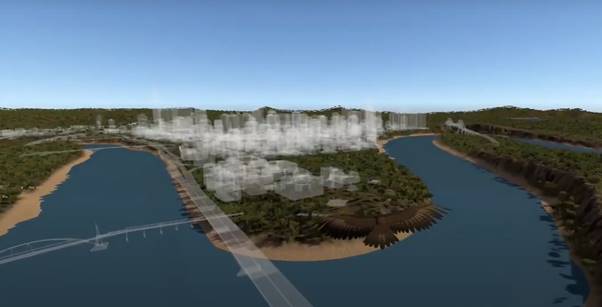
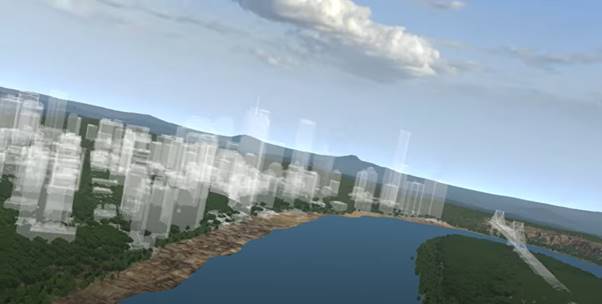
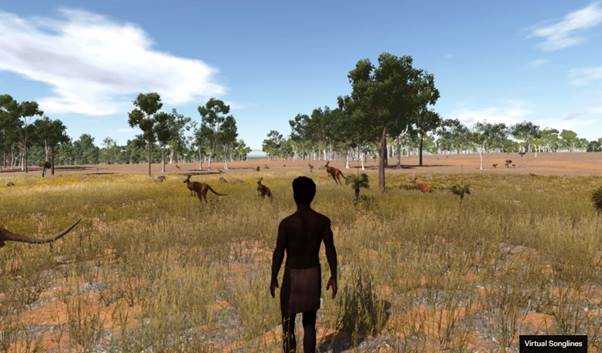 Then and now, Circular Quay, Sydney Harbour
Then and now, Circular Quay, Sydney Harbour 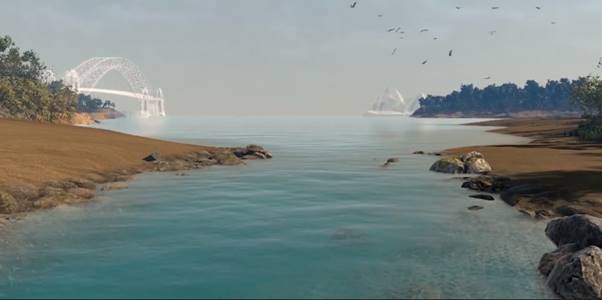 Spear fishing on the Parramatta River
Spear fishing on the Parramatta River 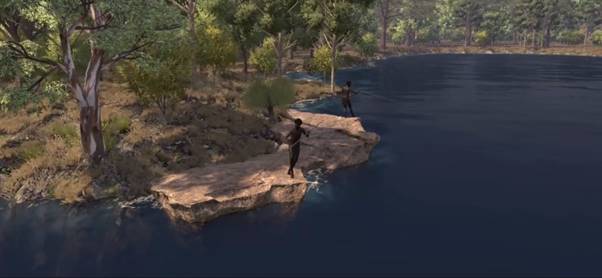
FINAL WORD FROM BRETT
We all have a cultural heritage that relates to our identity. At Virtual Songlines, we apply our skills, expertise and efforts to the true and accurate rendering of this connection to country. In this way, cultural heritage for all people across the world can be represented in a serious games format and so virtual heritage has potential everywhere and for any time and space - even the future of interactive entertainment and television.
* “While we may no longer be the title holders to this land across which Maiwar meanders, the Jagera, the Turrbal and the Yuggera are still connected in a spiritual way to this country. The land is special as it holds the memories, the traditions, the culture and the hopes of our first peoples. We will remember and not forget that below the bricks, the mortar, the concrete, and the asphalt, that this land was, and always will be, the traditional country of the original custodians. The flag of the watch tower pays respect to the Elders, past, present and future. To the Turrbal, Jagera and the Yuggera people. The traditional custodians, they're the country for its values, its resources, for its culturally significant places. And the stories that interweave amongst the obligations to areas and its landscape features.”
* From interview with Brett hosted by ACMI, Australia's national museum of screen culture

